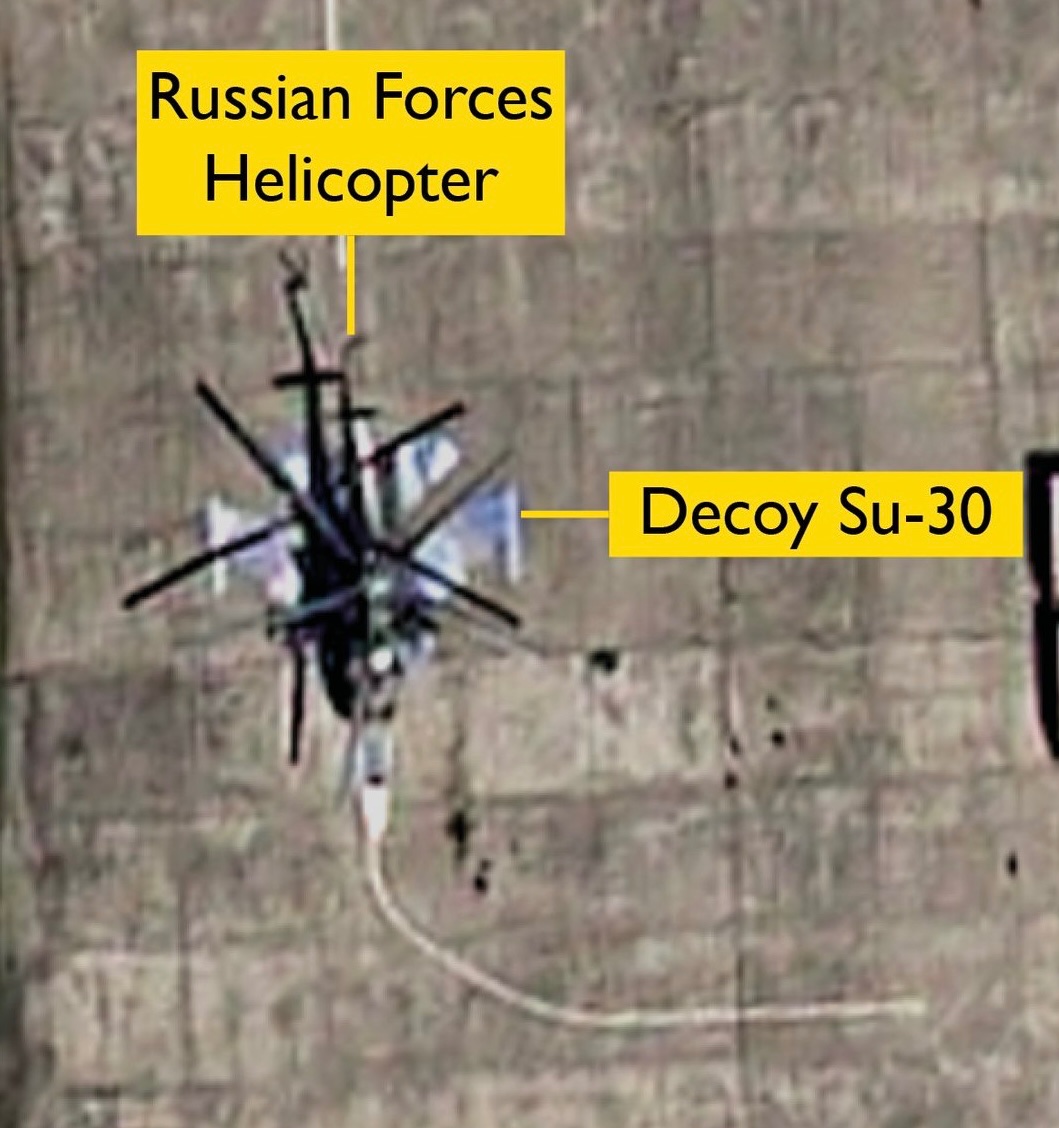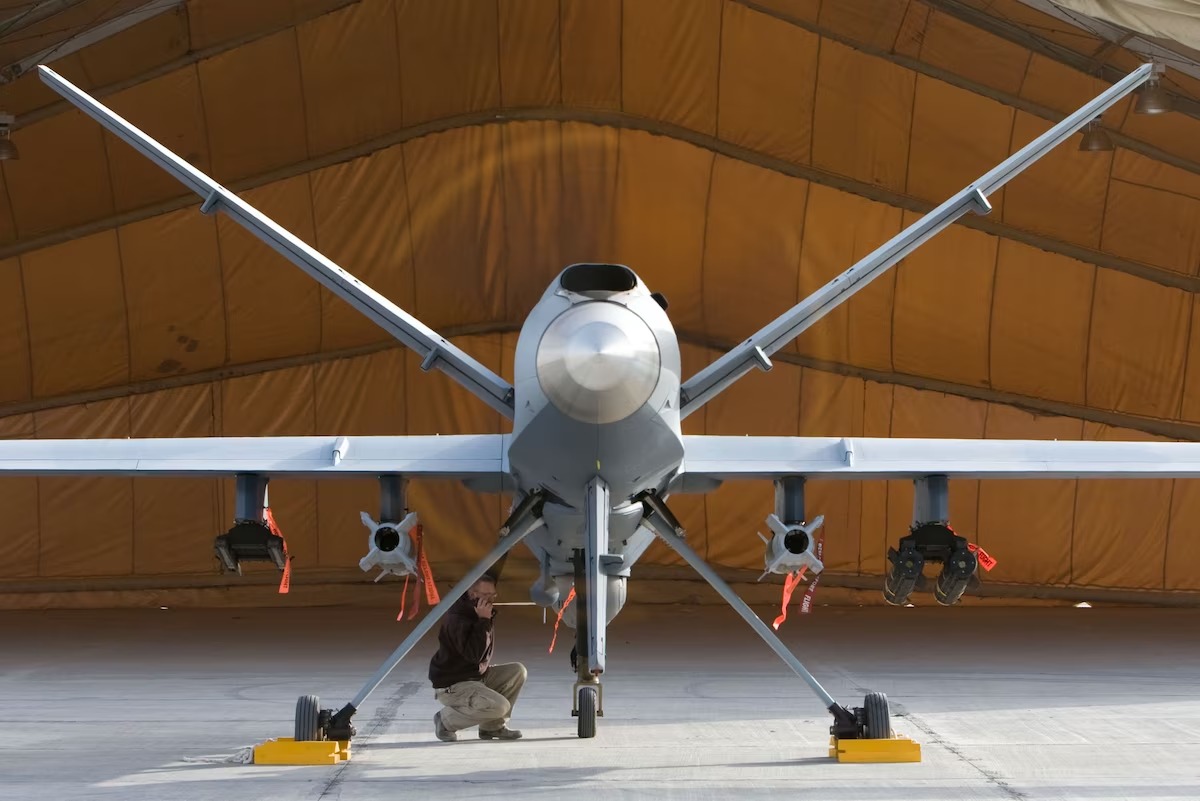An attempt by Russia to disguise its military aircraft ended in an embarrassing failure, where another aircraft was spotted parked over the ‘painted silhouette’ of a decoy, meant to be presented as a false target.
‘X-Factor’ Behind Su-34 Shootdowns, Australian E-7A Wedgetail Ends Support To Ukrainian Military
The United Kingdom’s (UK) Ministry of Defence’s (MoD) Defence Intelligence update in Ukraine posted an overhead satellite picture of the Kirovskoe air base in Crimea on X (formerly Twitter). The photo showed a helicopter parked on the airside over a painting of what could be a Sukhoi Su-27, Su-30, or Su-35.
Helicopter Lands On Jet?
The helicopter cannot be identified; it appears to have four rotors, based on the number of shadows it has cast on the ground. No rotary wing aircraft in the current Russian inventory, including the Mil Mi-17, Mi-8, or even the Mi-35 or Mi-28 Havoc attack helicopter gunships, have four rotor blades; they have a five-blade configuration.
If present, a fifth blade may be hidden as it might be aligned with the tail boom in a stationary position. Otherwise, the picture is very grainy, and an attempt to zoom in and identify the helicopter from the top is challenging.
The helicopter’s landing on the painted decoys can only be attributed to poor operational security discipline. The pilot or crew may have accidentally overlooked instructions not to park at painted spots. Or, the base might have been facing an infrastructure shortage at the time, with more aircraft operating than the available space.

These conclusions are, however, broadly in the realm of speculation, and it would help if a series of photographs taken over time from the base were available to shed more light on aircraft landing or deception paint patterns.
If the same painted Sukhoi fighter is ‘empty’ and covered with an aircraft at different intervals, it will provide insight into the flight operations schedule.
“Russian helicopters still regularly landing on the painted decoy fighter silhouettes completely undermine the deception attempt,” the UK MoD said. The note added that this also reveals the true order of battle or aircraft strength at these air bases, which Russia is likely to mask from Ukraine’s intelligence picture.
The decoy techniques are adopted due to “continued successful Ukrainian strikes on military locations (forcing) Russia to implement decoy and deception techniques.” The aim is to “obfuscate Ukrainian targeting attempts.”
Navy Base Painted Submarine Decoys Too
Apart from the airfield in question — Kirovske in Crimea — such paintings have also been “observed across at least 12 more Russian air bases, demonstrating the extent of Russian concern of future Ukrainian strikes and the need to repel them.”
Late in March, the UK MoD also observed another “maskirovka” attempt at the Novorossiysk port in mainland far-west Russia having a “decoy submarine” painted near a Kilo-class diesel-electric conventional submarine at a pier.
It noted that Russia places a “high emphasis on the use of camouflage and deception techniques to enhance the survivability of Russian forces.”
Latest Defence Intelligence update on the situation in Ukraine – 20 March 2024.
Find out more about Defence Intelligence's use of language: https://t.co/aCbSXPVpTt #StandWithUkraine 🇺🇦 pic.twitter.com/DmWPWyqVUk
— Ministry of Defence 🇬🇧 (@DefenceHQ) March 20, 2024
In the early phases of the war, “effective maskirovka” was “lacking.” The Russians improved techniques to “mitigate the heavy losses sustained over the past two years both in the Black Sea Fleet and Aerospace Forces.
The BSF has particularly colored their warships’ bow and stern in black paint, “likely to make their warships appear smaller and less appealing targets.”
Other analysts believe it could be to hide the silhouette of the warships from the optical seekers of cruise missiles like the Storm Shadow/SCALP-EG that match the feed from the images of the targets stored in their memory. Silhouettes of vessels have also been painted on the side of quays, probably to confuse Ukrainian uncrewed aerial vehicle operators.
Interestingly, Novorossiysk is also the base where the BSF moved its headquarters and a majority of its fleet after Ukraine destroyed the main HQ building in a 2023 strike with Storm Shadow missiles.
Ukrainian kamikaze boat strikes on the BSF are carried out with US and NATO targeting and surveillance information through special mission aircraft like the RQ-4B Global Hawk, MQ-9 Reaper drones, or the RC-135 Rivet ELINT aircraft.

If Ukraine had attacked Novorossiysk too, Russia planned to publicize that the West continued the sea war on internationally recognized sovereign Russian territory.
Even so, Russian aircraft are still vulnerable to conventional shootdowns while in the air, and its ships are still vulnerable while on operation in the Black Sea. “It is unlikely the use of maskirovka techniques will lead to any significant reduction in losses,” the MoD added.
- The author can be reached at satamp@gmail.com
- Follow EurAsian Times on Google News




